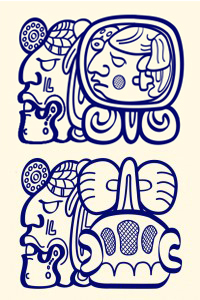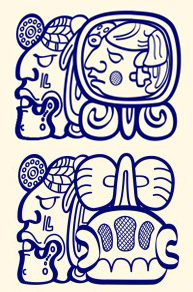
12 Ajaw 13 Sak. Drawing by Jorge Pérez de Lara.
At this time of the year, we remember the Ancestors in the great tradition of Día de los Muertos, which extends back to the time of the Ancient Ancestors themselves. We remember our collective work, and the very name of our organization, MAM, which also means ‘Ancestor’. In this month, full of jack-o-lanterns and spirits, remember that the very first story of a pumpkin-headed man is to be found in the K’iche’ Maya story of the Popol Vuh, when a carved pumpkin replaces the head of the Hero Twin, Hunahpu, as his own head becomes the ball in the game he plays with his brother against the Lords of Death in the underworld of Xibalbá. With the help of a rabbit, who distracts their adversaries by pretending to be the ball, Hunahpu retrieves his original head and then uses the pumpkin as the ball, which spreads its seeds far and wide as soon as it is kicked. This is an origin story not only for the first jack-o-lantern, but for the pumpkin itself, which comes to us from thousands of years of domestication by the Mesoamericans. We owe much to the rich traditions of the Maya and the peoples of Mesoamerica.
This month, we are honored to publish a report from Hermelinda Gómez López, a first-time recipient of one of our mini-grants from Las Margaritas, Chiapas in Mexico. After participating in a pre-Congreso event last year in Chiapas, Maestra Gómez López has decided to share what she has learned with Tojol-ab’al Maya students in her community in order to help teach and preserve the rich culture of their ancestors.
Best wishes to you and your family during this season of remembrance and gratitude, and may the ancestors never be forgotten.
Ts’acatal,
Michael J. Grofe, President
MAM

Teams formed syllabic words with the help of the syllabary
Strengthening Knowledge about Ojer Maya’ Tz’iib’: the Revitalization of the Language and the Maya Culture of Our Ancestors
Through this medium I am pleased to present my report of activities of the workshop of Maya Epigraphy or Ancient Mayan Writing, carried out on April 26 and 27 of the present year in the town of Rafael Ramírez, in the municipality of Las Margaritas, Chiapas, thanks to the mini-grant funds granted by Mayas for Ancient Mayan foundation.
Once we clarified the change of headquarters, the Maya epigraphy workshop was carried out on April 26 and 27 without any setbacks, managing to train 35 students speaking the Mayan language Tojol-ab’al in the College of Bachilleres of Chiapas (COBACH) 290 from the town of Rafael Ramírez, municipality of Las Margaritas, Chiapas, Mexico.

Start of the Maya Epigraphy Workshop
On April 26 I arrrivd in the town of Rafael Ramírez to carry out the workshop. I went with Juan Alberto Toledo Herrera, Assistant Director , who gave me the classroom that they have equipped as a computer center because it is one of the largest spaces they have, and he also lent me the projector to facilitate the workshop. Once the place was set up, the workshop began welcoming the participants, and later with the support of the slides, we announced the purpose of the workshop as “Strengthening the knowledge about Ancient Maya Writing (Ojer Maya’ Tz’iib’), the revitalization of the language and the Mayan culture of our ancestors.” Also, I gave a brief introduction about the importance of the writing of the Ojeer Maya’ Tz’iib’ as a heritage of our grandfathers and grandmothers. I povided a small description of the Tz’iib’, that in Tojol-ab’al is ts’ijb’anel by the Aj Aj’iib’ (Ts’ijb’anum or ‘Scribe’), with the support of images such as stelae, codices, vessels and with images where the Aj Tz’iib’ appears painting or writing on some surface. In the same way, they were given a small introduction about the Tojol-ab’al literacy and Maya epigraphy, making a small comparison of the writing of our ancestors with the way of writing today. Finally, the aim was to raise awareness among young people of being proud of their roots and of appreciating the ancestral knowledge that exists in their community.

Individual advice on the use of the syllabary
On the 27th there was a review of the form of writing of our ancestors, and the use of the Maya syllabary was explained, along with its pronunciation, writing and the structure of words, the signs they represent, the formation of words in syllables and the numbering from 1 to 20. Subsequently, the young people did exercises to put into practice the knowledge they acquired on the subject, which they were happy and excited to do, as it was the first time they were given this type of workshop.

Doing exercises as a team
Finally, it should be noted that for both the young people and myself, the workshop was very satisfying as it helps to reinforce knowledge and cultural values. I thank our brothers from Guatemala for their teachings and for keeping in mind one of the most precious treasures we have as indigenous peoples, which is our language. Through it, we can know and transmit our roots and we can strengthen it by reading and writing the Tz’iib’ system.
I was able to carry out this workshop successfully, thanks to the manual “Introduction to the reading and writing of the Tz’iib system” offered at the Maya Epigraphy Pre-Congreso “Introduction to the operation and use of the Ojeer Maya’ Tz’iib’,” which took place on November 21st, 22nd and 23rd, 2017 in the city of Comitan de Domínguez, Chiapas, organized by the Documentation Center of the Tojol-ab’al Language (CDIT) through the teacher K’anal Ajpub, María Betha Sántiz Pèrez, and the Intercultural University of Chiapas (UNICH) in coordination with the Fundación Proyecto Lingüístico Francisco Marroquín (PLFM), the Rafael Landivar University of Guatemala, and Mayas for Ancient Mayan (MAM).
Sincerely,
Hermelinda Gómez López
Tojol-ab’al Maya speaker

Church in the town of Rafael Ramírez


12 Ajaw 13 Sak. Dibujo por Jorge Pérez de Lara.
En esta época del año, recordamos a los Ancestros en la gran tradición del Día de los Muertos, que se remonta a la época de los antiguos Ancestros. Recordamos nuestro trabajo colectivo y el nombre mismo de nuestra organización, MAM, que también significa ‘Ancestro’. En este mes, lleno de calabazas talladas y espíritus, recuerda que la primera historia de un hombre con cabeza de calabaza se encuentra en la historia Maya K’iche’ del Popol Vuh, cuando una calabaza tallada reemplaza a la cabeza del héroe gemelo, Hunahpu, como su propia cabeza se convierte en el balón en el juego que juega con su hermano contra los Señores de la Muerte en el inframundo de Xibalbá. Con la ayuda de un conejo, que distrae a sus adversarios haciéndose pasar por la pelota, Hunahpu recupera su cabeza original y luego usa la calabaza como la pelota, que extiende sus semillas a lo largo y ancho tan pronto como la patean. Esta es una historia de origen no solo para el primer Jack-O’-Lantern, sino para la calabaza en sí misma, que nos llega de los miles de años de domesticación de los mesoamericanos. Le debemos mucho a las ricas tradiciones de los mayas y los pueblos de Mesoamérica.
Este mes, nos sentimos honrados de publicar un informe de Hermelinda Gómez López de Las Margaritas, Chiapas, en México, que recibió por primera vez una de nuestras mini subvenciones. Después de participar en un evento pre-Congreso el año pasado en Chiapas, la maestra Gómez López ha decidido compartir lo que ha aprendido con los estudiantes Tojol-abales en su comunidad para ayudar a enseñar y preservar la rica cultura de sus antepasados.
Mis mejores deseos para usted y su familia durante esta temporada de recuerdo y agradecimiento, y que los antepasados nunca sean olvidados.
Ts’acatal,
Michael J. Grofe, President
MAM

En equipos formado palabras silabicas con ayuda del silabario
Fortalecer el conocimiento sobre la escritura del Ojeer Maya´ Tz’iib´, para la revitalización de la lengua y la cultura maya de nuestros antepasados
A través de este medio me complace presentar mi informe de actividades del taller de Epigrafía Maya o escritura maya antigua gracias a los fondos minibecas otorgado por la fundación Maya Antigua para los Mayas, lo cual fue llevado a cabo los días 26 y 27 de abril del presente año en la localidad de Rafael Ramírez, municipio de Las Margaritas, Chiapas.
Una vez aclarado el cambio de sede informo que durante los días 26 y 27 de abril se llevó a cabo el taller de epigrafia maya sin ningún contratiempos, logrando capacitar a 35 alumnos hablantes de la lengua maya Tojol-ab’al en el Colegio de Bachilleres de Chiapas (COBACH) 290 de la localidad de Rafael Ramírez, municipio de Las Margaritas, Chiapas, México.

Inicio del taller de epigrafia maya
El día 26 de abril me trasladé a la localidad de Rafael Ramírez para llevar a cabo el taller. Me dirigí con Juan Alberto Toledo Herrera, asistente del Director, quien me facilitó el aula que tienen acondicionado como centro de cómputo por ser uno de los espacios más amplios que tienen, así mismo, me prestó el cañon proyector para facilitar el taller. Una vez acondicionado el lugar dio inicio el taller dándole la bienvenida a los participantes, posteriormente con el apoyo de las diapositivas se dio a conocer el propósito del taller que fue “Fortalecer el conocimiento sobre la escritura del Ojeer Maya´ Tz’iib´, para la revitalización de la lengua y la cultura maya de nuestros antepasados.” Así mismo, se dio una pequeña introducción acerca de la importancia de la escritura del Ojeer Maya’ Tz’iib’ como herencia de nuestros abuelos y abuelas. Se hizo una pequeña describción del Tz’iib’ que en Tojol-ab’al es ts’ijb’anel y del Aj tz’iib’ (Ts’ijb’anum o ‘el Escribidor’) con apoyo de imágenes como estelas, códices, vasijas y con imágenes en dónde aparece el aj tz’iib’ pintando o escribiendo sobre alguna superficie. De igual manera, se les dio una pequeña introducción sobre la lecto-escritura Tojol-ab’al y de la epigrafía maya, haciendo una pequeña comparación de la escritura de nuestros antepasados con la forma de escribir en la actualidad. Por último, se trató de concientizar a los jóvenes de sentirse orgullosos de sus raices y de valorar los conocimientos ancestrales que existen en su comunidad.

Asesoría individual del uso del silabario
El dia 27 se hizo un repaso de lo que es la forma de escritura de nuestros antepasados, se explicó acerca del uso del silabario maya, su pronunciación, su escritura y estructura de las palabras, los signos que representan, la formación de palabras en silabas y la numeración del 1 al 20. Posteriormente los jóvenes hicieron ejercicios para poner en práctica el conocimiento adquirido sobre el tema, los cuales estaban contentos y emocionados ya que era la primera vez que les daban este tipo de taller.

En equipo haciendo ejercicios
Por último, cabe señalar que tanto para los jóvenes como para mí el taller fue de gran satisfacción ya que permite reforzar los conocimientos y los valores culturales. Agradezco a los hermanos de Guatemala por sus enseñanzas y por tener presente uno de los tesoros mas preciados que tenemos como pueblos indígenas que es la lengua ya que atravéz de ella podemos conocer y transmitir nuestras raíces y fortalecerla mediante la lectura y escritura del sistema Tz’iib’.
Pude llevar a cabo este taller satisfactoriamente gracias al manual de “Introducción a la lectura y escritura del sistema Tz’ib¨ brindado en el Precongreso de Epigrafía Maya “Introducción al funcionamiento y uso del Ojeer Maya´ Tz’ib´,” que se llevó a cabo los días 21, 22 y 23 de noviembre de 2017 en la ciudad de Comitan de Domínguez, Chiapas, organizado por el Centro de Documentación del Idioma Tojol-ab’al (CDIT) a través de la maestra K’anal Ajpub, María Betha Sántiz Pèrez, y la Universidad Intercultural de Chiapas (UNICH) en coordinación con la Fundación Proyecto Lingüístico Francisco Marroquín (PLFM), la Universidad Rafael Landivar de Guatemala, y Maya Antiguo para los Mayas (MAM).
Atentamente,
Hermelinda Gómez López
Maya hablante Tojol-ab’al

Iglesia de la localidad de Rafael Ramírez
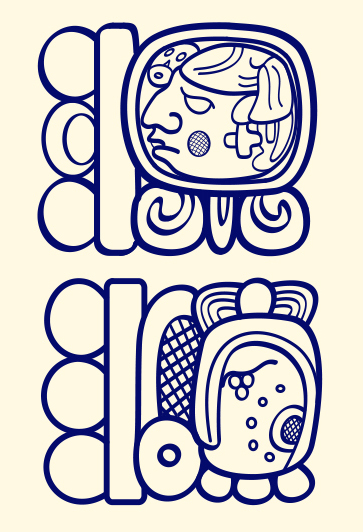








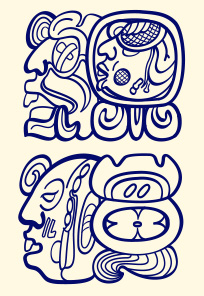

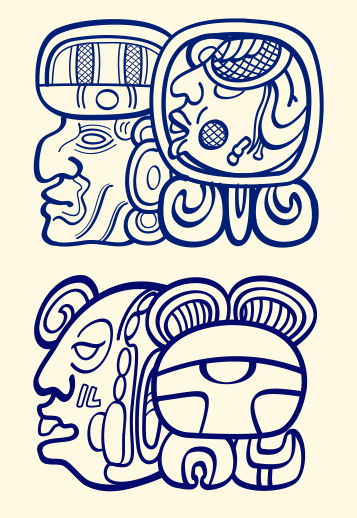

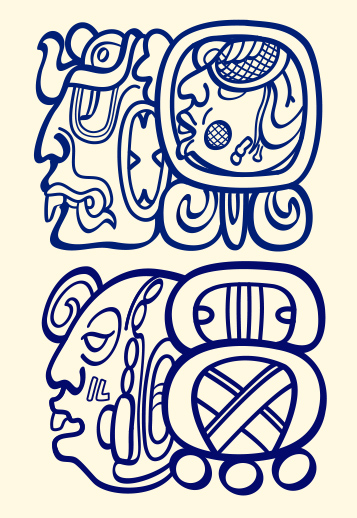



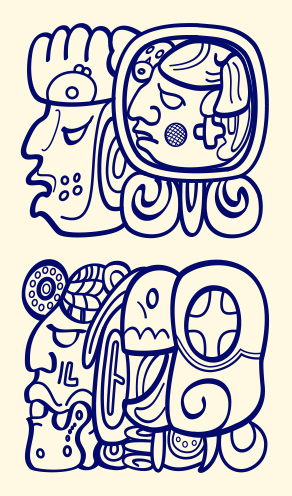

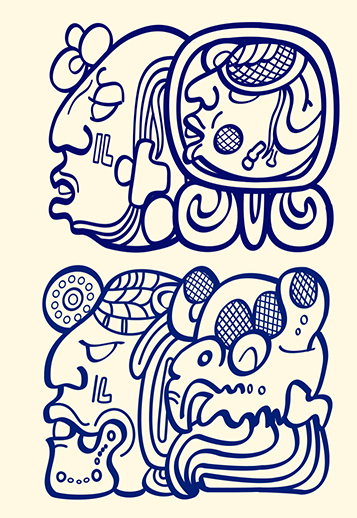
 Recognition of the cultural and epigraphic development of Becán
Recognition of the cultural and epigraphic development of Becán 
